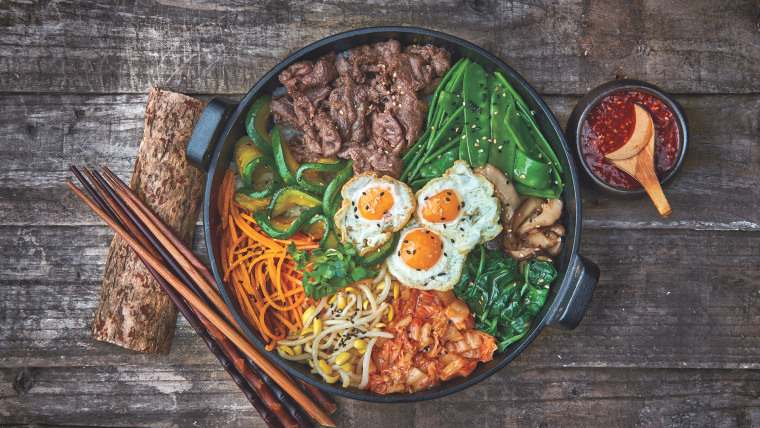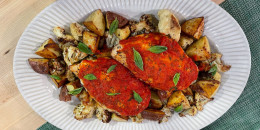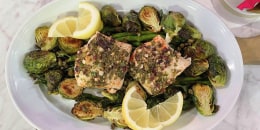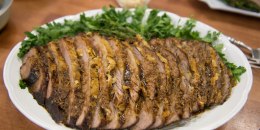Chef notes
Bibimbap is one of my favorite dishes because I love eating vegetables. It's also very healthy. I've simplified this version slightly by making one seasoning mix for all of the vegetables. Traditionally, each vegetable would be seasoned individually. It does better keep the integrity of the flavors, but it is tedious. I've compromised by cooking each one separately, but using the same seasoning. It might seem silly, but it makes a big difference in the finished dish. If you're feeling adventurous, make your own cabbage kimchi [LINK TKTK] to serve with this delicious dish.
Technique tip: The cooking of this dish goes very quickly, so be sure you have all the ingredients ready before you start.
Swap option: The variety of vegetables doesn't really matter too much — use whatever you have. Chopped lettuce leaves or cucumber add a nice crunch, too.
Ingredients
- 3 tablespoons gochujang (Korean chile paste)
- 2½ tablespoons mirin
- 2 teaspoons sugar
- 2 teaspoons roasted sesame seeds
- 1 teaspoon toasted sesame oil
- 1 teaspoon thinly sliced scallions (sliced on an angle)
- 2 cups short or medium grain Korean rice
- 2 tablespoons toasted sesame oil
- 5 cups steamed white rice (recipe above)
- 3 tablespoons soy sauce
- 3 tablespoons mirin
- 2 cloves garlic, grated or minced
- 1 teaspoon grated peeled fresh ginger
- 1 teaspoon crushed roasted sesame seeds
- 1/4 pound very thinly sliced beef bulgogi meat or rib eye
- 2 teaspoons sugar
- Vegetable oil, for frying
- 1 cup soybean sprouts, tails and any soft or brown pieces removed, rinsed and dried well
- 1/4 pound shiitake mushrooms, stemmed and cut into 1/4-inch slices
- 1/2 medium zucchini, thinly sliced on an angle
- 1 cup snow peas
- 1 carrot, cut into matchsticks
- 6 cups baby spinach
- 1/2 cup cabbage kimchi, homemade or store-bought
- Gochujang sauce (recipe above)
- 3 large egg yolks or fried eggs
- Black sesame seeds
- Radish sprouts (optional)
Preparation
For the gochujang sauce:
In a small bowl, stir together all the ingredients. Cover and store in the refrigerator if not using immediately.
For the steamed white rice:
In a medium saucepan with a tight fitting lid, combine the rice and enough cold tap water to cover it. Swish the rice around with one hand until the water becomes cloudy and then slowly pour the water out, using your hand to keep the rice from falling out of the pot. Repeat two or three more times, until the water runs mostly clear; drain well.
Add 2 cups of water (add up to 1/4 cup more if you like softer rice). Steam, covered, over medium-low heat until all the water has been absorbed, about 30 minutes. It's important to refrain from lifting the lid while the rice cooks. I like to set a timer so I can go about my business and not worry about forgetting it. Remove the saucepan from the heat and let it sit, covered and undisturbed, for 10 minutes. Uncover the pot and gently fold the rice over itself with a rice paddle or rubber spatula a few times before serving.
For the bibimbap:
1.Heat a large heavy-bottomed skillet (preferably cast iron) over medium heat. Add 1 tablespoon of the sesame oil and gently spread the rice over the bottom of the skillet in a loose layer. Cook, undisturbed, until the bottom of the rice develops a golden crust, 8 to 10 minutes. This should be about the same time the toppings are done, but if the rice is ready beforehand, just turn off the heat.
2.Meanwhile, in a small bowl, stir together the soy sauce, 2 tablespoons of the mirin, the remaining 1 tablespoon sesame oil, the garlic, ginger and sesame seeds. Mix 2 tablespoons of the sauce with the beef and sugar and set aside. Set the remaining seasoning sauce by the stove.
3.In a medium nonstick skillet, heat 1/2 teaspoon of vegetable oil over medium-high heat. Add the bean sprouts and 1 teaspoon of the seasoning sauce and cook, stirring, until crisp-tender, about 30 seconds. Arrange the bean sprouts on a section of the rice (as each vegetable topping is finished, arrange it on a section of the rice in the skillet so the toppings resemble the spokes of a bicycle wheel).
4.Heat 2 teaspoons of oil in the skillet, add the beef, and cook until cooked through, 1 to 2 minutes. Arrange the beef on the rice.
5.Heat 1 tablespoon of oil in the skillet, add the mushrooms and 1 tablespoon of the sauce, and cook until tender, 1 minute. Arrange the mushrooms on the rice.
6.Heat 1/2 teaspoon of oil in the skillet, add the zucchini and 2 teaspoons of the sauce, and cook until just tender, about 1 minute. Arrange the zucchini on the rice.
7.Heat 1/2 teaspoon of oil in the skillet, add the snow peas and 2 teaspoons of the sauce, and cook until crisp-tender, 45 seconds. Arrange the snow peas on the rice.
8.Heat 1/2 teaspoon of oil in the skillet, add the carrot and 1 teaspoon of the sauce, and cook until crisp-tender, 30 seconds. Arrange the carrot on the rice.
9.Finally, heat 1 teaspoon oil in the skillet, add the spinach and 1 tablespoon of the sauce, and cook until just wilted, 30 seconds. Arrange the spinach on the rice.
10.Deglaze the pan with the remaining 1 tablespoon mirin, scrape up any browned bits from the bottom, and spoon the juices from the skillet over the meat on the rice. Arrange the kimchi on a section of the rice.
11.Spoon the gochujang sauce on the center of the rice or serve on the side, if you like. Make a little well in the spinach, mushrooms, and beef and gently put an egg yolk into each or arrange the fried eggs, if using, over the dish. Sprinkle the bibimbap with black sesame seeds and radish sprouts, if desired. Bring the skillet to the table, set it on a trivet, and mix everything together before spooning into bowls.
Recipe from Korean Food Made Simple. Copyright © 2016 by Judy Joo. Reproduced by permission of Houghton Mifflin Harcourt. All rights reserved.
TODAY has affiliate relationships, so we may get a small share of the revenue from your purchases. Items are sold by the retailer, not by TODAY.














